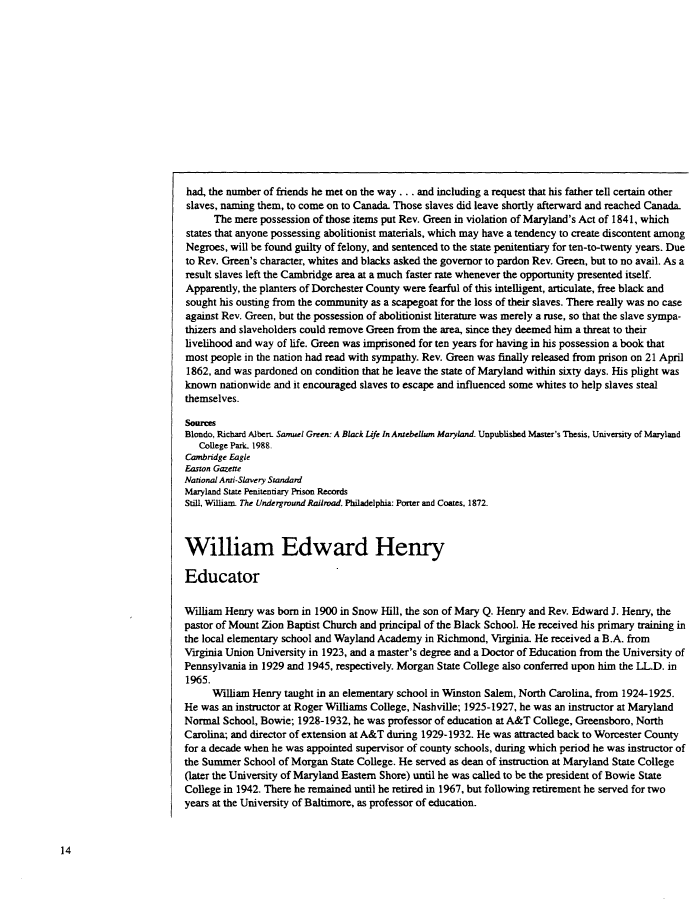 |
||||
|
TASK FORCE TO STUDY THE HISTORY AND LEGACY OF SLAVERY IN MARYLAND (Final Report) 1999/12/31 MdHR 991422 MdHR 991422, Image No: 374 Print image (78K) |
 |
||||
|
TASK FORCE TO STUDY THE HISTORY AND LEGACY OF SLAVERY IN MARYLAND (Final Report) 1999/12/31 MdHR 991422 MdHR 991422, Image No: 374 Print image (78K) |
| had, the number of friends he met on the way ... and including a request that his father tell certain other slaves, naming them, to come on to Canada. Those slaves did leave shortly afterward and reached Canada. The mere possession of those items put Rev. Green in violation of Maryland's Act of 1841, which states that anyone possessing abolitionist materials, which may have a tendency to create discontent among Negroes, will be found guilty of felony, and sentenced to the state penitentiary for ten-to-twenty years. Due to Rev. Green's character, whites and blacks asked the governor to pardon Rev. Green, but to no avail. As a result slaves left the Cambridge area at a much faster rate whenever the opportunity presented itself. Apparently, the planters of Dorchester County were fearful of this intelligent, articulate, free black and sought his ousting from the community as a scapegoat for the loss of their slaves. There really was no case against Rev. Green, but the possession of abolitionist literature was merely a ruse, so that the slave sympathizers and slaveholders could remove Green from the area, since they deemed him a threat to their livelihood and way of life. Green was imprisoned for ten years for having in his possession a book that most people in the nation had read with sympathy. Rev. Green was finally released from prison on 21 April 1862, and was pardoned on condition that he leave the state of Maryland within sixty days. His plight was known nationwide and it encouraged slaves to escape and influenced some whites to help slaves steal themselves. Sources Blondo, Richard Albert. Samuel Green: A Black Life In Antebellum Maryland. Unpublished Master's Thesis, University of Maryland College Park. 1988. Cambridge Eagle Boston Gazette National Anti-Slavery Standard Maryland State Penitentiary Prison Records Still, William. The Underground Railroad. Philadelphia: Porter and Coates, 1872. William Edward Henry Educator William Henry was born in 1900 in Snow Hill, the son of Mary Q. Henry and Rev. Edward J. Henry, the pastor of Mount Zion Baptist Church and principal of the Black School. He received his primary training in the local elementary school and Way land Academy in Richmond, Virginia. He received a B.A. from Virginia Union University in 1923, and a master's degree and a Doctor of Education from the University of Pennsylvania in 1929 and 1945, respectively. Morgan State College also conferred upon him the LL.D. in 1965. William Henry taught in an elementary school in Winston Salem, North Carolina, from 1924-1925. He was an instructor at Roger Williams College, Nashville; 1925-1927, he was an instructor at Maryland Normal School, Bowie; 1928-1932, he was professor of education at A&T College, Greensboro, North Carolina; and director of extension at A&T during 1929-1932. He was attracted back to Worcester County for a decade when he was appointed supervisor of county schools, during which period he was instructor of the Summer School of Morgan State College. He served as dean of instruction at Maryland State College (later the University of Maryland Eastern Shore) until he was called to be the president of Bowie State College in 1942. There he remained until be retired in 1967, but following retirement he served for two years at the University of Baltimore, as professor of education. 14 |